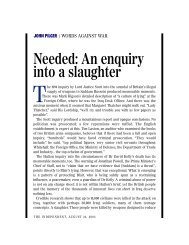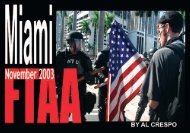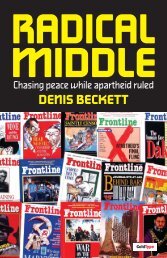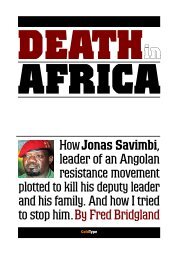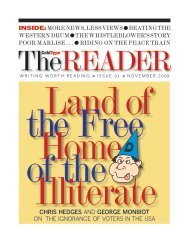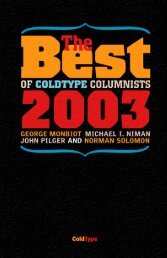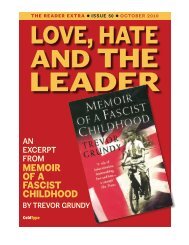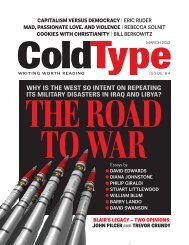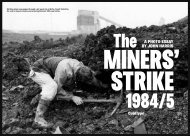Create successful ePaper yourself
Turn your PDF publications into a flip-book with our unique Google optimized e-Paper software.
By DAVE MARSH<br />
Standing by the side of Cleveland’s brand-new Rock<br />
and Roll Hall of Fame stage, Soul Asylum’s Dave<br />
Pirner held a card instructing him to introduce<br />
Robbie Robertson. (Hometown ID being the<br />
order of the evening, I suggested, “Hey, hosers!<br />
Hold on to your toques — from Toronto, here’s<br />
Robbie Robertson!”) Pirner had bigger things on his mind.<br />
“This is all kinda sentimental,” he complained. “You’ve<br />
gotta draw that line. I mean, I know I step over it all the time,<br />
and I’ll probably keep doing it, but all this …”<br />
“Nah,” I said. “Your job isn’t to draw lines. It’s to dance all<br />
over the line.” Pirner laughed. “Yeah, I guess … But don’t you<br />
think this is all gettin’ pretty institutionalized?”<br />
“Hey, you were just on stage with Iggy. Ask him. We<br />
fought that battle 25 years ago, and we lost a lotta parts of it.<br />
The question now isn’t whether rock ’n’ roll is gonna be institutionalized.<br />
It’s whether we’re going to have good institutions<br />
or bad ones.”<br />
As always, Pirner was asking the right questions — the<br />
ones that made the night and the existence (at long last) of<br />
the Rock and Roll Hall of Fame Museum, exciting. Could<br />
we get it right? Was it worth the bother? I had the right<br />
answers, at least for that moment, but only because I’d actually<br />
been through the museum. Seeing the place had forcibly<br />
reminded me why this night was no ordinary HBO extravaganza.<br />
As if a show that featured Bob Dylan, Aretha<br />
Franklin, James Brown, Jerry Lee Lewis and Little Richard,<br />
and used Booker T. and the MGs and the E Street Band as<br />
its main backing bands, could have had anything ordinary<br />
about it.<br />
Soul Asylum had just played its heart out behind Iggy’s<br />
Back Door Man and Lou Reed’s Sweet Jane. Earlier, Al Green<br />
shocked even his biggest fans with a set that climaxed with a<br />
rendition of Sam Cooke’s A Change is Gonna Come that<br />
proved the concert’s supreme highlight. Bruce Springsteen<br />
and the E Street Band backed Chuck Berry on a flawless<br />
Johnny B. Goode to open the show. Then, of all the damn<br />
things, Bon Jovi lent powerful support to Eric Burdon on a<br />
set of Animals songs that climaxed with We’ve Gotta Get<br />
Outta This Place.<br />
At that point, I had to laugh. For Chrissie Hynde — who<br />
shortly thereafter battered her way through My City Was<br />
COLDTYPE<br />
METROTIMES, DETROIT<br />
Building a home<br />
for rock ’n’ roll<br />
Badly lit, claustrophobic, and — for my taste —<br />
the greatest museum in the world<br />
Gone and a beautiful version of The Needle and the Damage<br />
Done, that served as tribute to both Neil Young and her own<br />
lost bandmates, We’ve Gotta Get Outta This Place must have<br />
once bespoken her determination to leave Cleveland’s environs.<br />
Now, the song paid the best sort of irony symbolized<br />
by the I.M. Pei building next door. That’s why we had come:<br />
Rock’s multigenerational rebellion had landed it in a $92million<br />
palace of swank.<br />
Well, pardon me, but I’m a rock ’n’ roll fan; I have been to<br />
the Rock and Roll Hall of Fame, and swank ain’t the half of<br />
it. For my taste, it is (give or take the Prado), the greatest<br />
museum in the world, and not only because it celebrates my<br />
culture. No, what’s great about this museum is that it celebrates<br />
that culture properly (confession of moderate selfinterest:<br />
I sit on the Hall’s nominating committee). Like the<br />
The question now isn’t<br />
whether rock ’n’ roll is gonna<br />
be institutionalized.<br />
It’s whether we’re gonna<br />
have good institutions<br />
or bad ones<br />
concert and its list of inductees, the Hall isn’t perfect —it’s<br />
too human and vital for that. The Hendrix and Motown displays<br />
are weak (although the Temptations’ costumes<br />
brought me back to my 15-year-old envy), Don Everly probably<br />
did give his dad that guitar but certainly not after writing<br />
Bye Bye Love, given that he didn’t write it; and no matter<br />
what the curators think, there is no memorabilia from Bruce<br />
Springsteen’s 1979 tour because he didn’t tour that year. The<br />
Hall of Fame itself is housed in an ill-lit, claustrophobic mausoleum<br />
stuck at the top of a virtually inaccessible staircase.<br />
So what? The triumphs and treasures within rock ’n’<br />
roll’s new palace far outweigh its inevitable flaws. You walk<br />
PAGE 4<br />
straight down the Ahmet N. Ertegun Exhibition Hall into<br />
the center of controversy, an exhibit of the history of<br />
attempts to censor and repress rock, featuring ’50s fanatics,<br />
Frank Zappa and Tipper Gore. (“Well, they made this just<br />
for you,” said a friend. “Nah, Dennis Barrie made this for<br />
himself,” I said. Barrie, the museum’s director, came to Cleveland<br />
from Cincinnati, where he had been busted — but ultimately<br />
prevailed — for displaying Robert Mapplethorpe<br />
photographs. Hopefully, his presence in the music world will<br />
stiffen the spines of his employers on such issues — maybe<br />
he’ll even be able to get Michael White, the mayor of Cleveland,<br />
to stop harassing rock clubs in his town.)<br />
Turn the corner and you’re into a series of displays focusing<br />
attention on regional and stylistic groupings: early rock<br />
(including a fabulous if hilarious Billy Lee Riley mannequin),<br />
grunge and punk, hip-hop and, on one wall, blues<br />
and R&B featuring everything from the handmade squareshaped<br />
guitar Bo Diddley made in high school 50 years ago<br />
to the battered black “money box” Howlin’ Wolf always kept<br />
right by his knee onstage to the torn-up fuselage of a small<br />
airplane bearing the words “Otis” and “Redding” in green<br />
paint on white metal.<br />
The hall’s movie theaters play Time-Life’s history of rock<br />
’n’ roll and more obscure films. In private carrels, you can<br />
hear late lamented deejays, discover the “best” 500 rock<br />
songs (pretty good selection) and learn how particular records<br />
were created. The display cases offer tributes to individual<br />
labels so good that Sam Phillips stood as if mesmerized<br />
at the Sun exhibit. All in all, it’s the most useful deployment<br />
of cybertechnology I’ve ever seen. The museum makes<br />
no false generic distinctions: P-Funk costumes and memorabilia<br />
stand next to smashed-up Who guitars and Keith<br />
Moon drumheads. And this goes on for three floors, including,<br />
among many many other things, an exhibit of rock magazines<br />
that includes the first issue of Creem with my byline<br />
in it, which made me proud as well as pleased. Just about<br />
every musician who saw the place felt the same way as ol’<br />
Sam and me, too.<br />
The difference between the Hall of Fame Museum and<br />
its most obvious analog, your average Hard Rock Café,<br />
doesn’t come from what’s on display. The Hard Rocks definitely<br />
have more gold records and framed electric guitars and<br />
maybe even a better selection of any given artist’s costumery.<br />
But the Hard Rock presents rock ’n’ roll as a jumble. The



